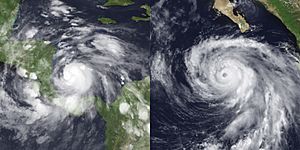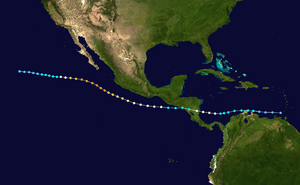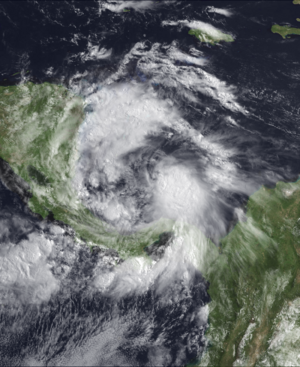Hurricane Cesar–Douglas facts for kids

Cesar (left) and Douglas (right) near their peak intensities on July 28 and August 1 respectively
|
|
| Meteorological history | |
|---|---|
| as Hurricane Cesar | |
| Formed | July 24, 1996 |
| Category 1 tropical cyclone | |
| 1-minute sustained (SSHWS/NWS) | |
| Highest winds | 85 mph (140 km/h) |
| Lowest pressure | 985 mbar (hPa); 29.09 inHg |
| Meteorological history | |
| as Hurricane Douglas | |
| Dissipated | August 6, 1996 |
| Category 4 tropical cyclone | |
| 1-minute sustained (SSHWS/NWS) | |
| Highest winds | 130 mph (215 km/h) |
| Lowest pressure | 946 mbar (hPa); 27.94 inHg |
| Overall effects | |
| Fatalities | 113 |
| Missing | 29 |
| Damage | $203 million (1996 USD) |
| Areas affected | |
|
Part of the 1996 Atlantic and Pacific hurricane seasons |
|
Hurricane Cesar–Douglas was a powerful tropical cyclone that made a rare journey from the Atlantic Ocean all the way to the Pacific Ocean. It was one of the few storms to keep going after crossing from one ocean basin to another. It was also the last storm to get two different names when it did this.
First, it was called Hurricane Cesar. This was the third named storm and second hurricane of the 1996 Atlantic hurricane season. It started in the southern Caribbean Sea and caused problems in several South American countries. Then, it crossed over Nicaragua and entered the Eastern Pacific Ocean.
Once it reached the Pacific, it was renamed Hurricane Douglas. It became the fourth named storm, third hurricane, and the first and strongest major hurricane of the 1996 Pacific hurricane season. Sadly, this storm caused the deaths of 113 people in Central and South America. Another 29 people went missing. Most of these deaths were due to severe flooding and dangerous mudslides.
Contents
How the Storm Formed and Grew
Hurricane Cesar began as a tropical wave. This is like a ripple in the atmosphere that can lead to storms. It came from the west coast of Africa on July 17. For several days, it moved west without getting organized. However, conditions high up in the atmosphere were good for a storm to form.
On July 22, more thunderstorms, called convection, started to appear as the wave got closer to the southern Windward Islands. The air pressure at the surface began to drop as the system moved through the Lesser Antilles. A spinning area of air, called a circulation, started to form near Trinidad and Tobago.
Experts believe the system became Tropical Depression Three on July 24, near Isla Margarita off the coast of Venezuela. At first, the National Hurricane Center (NHC) didn't officially call it a tropical depression until 18 hours later.
Cesar's Journey Through the Caribbean
A very strong area of high pressure was over The Bahamas. This pushed the tropical depression westward through the southern Caribbean, close to the northern coast of South America. On July 25, it hit the island of Curaçao. The island reported winds of 45 miles per hour (72 km/h). This showed the storm had become a tropical storm. However, the NHC didn't officially name it Cesar until the next day.
After passing Curaçao, the storm moved near or over the Guajira Peninsula in northern Colombia. Being so close to South America stopped it from getting much stronger. But by late on July 26, the storm reached the open waters of the southwest Caribbean Sea.
On July 27, Cesar became a hurricane. It was about halfway between Nicaragua and Colombia. Later that day, the hurricane passed over San Andrés island. As Cesar got closer to Central America, a clear, calm center called an eye formed. This eye was surrounded by strong thunderstorms in a ring called an eyewall.
Around 4:00 AM UTC on July 28, Hurricane Cesar made landfall just north of Bluefields, Nicaragua. Its winds were about 75 miles per hour (121 km/h). It moved quickly west-northward across the country. It weakened back to a tropical storm and then entered the eastern Pacific Ocean by July 29.
Cesar Becomes Douglas
Cesar was the most recent tropical cyclone to cross from the Atlantic to the Pacific until Hurricane Otto did the same in 2016. After Cesar–Douglas, a new rule was made. Future storms that cross from one ocean to another would keep their original name.
When Cesar reached the Pacific, it was first called Tropical Depression Seven-E. But after looking at the storm again, experts realized it had stayed a tropical storm while crossing Central America. So, it was renamed Tropical Storm Douglas. At that time, the rule was to rename storms if they crossed from the Atlantic to the Pacific.
Douglas Strengthens in the Pacific
As Douglas moved westward, it quickly got stronger. An eye-like feature appeared by 9:00 AM UTC on July 29. Soon after, Douglas became a hurricane. It was about 115 miles (185 km) southwest of the Guatemala/Mexico border.
By late on July 29, the hurricane's eye was very clear on Mexican radar. With good conditions high in the atmosphere, warm ocean waters, and an area known for strong hurricanes, experts thought Douglas would get even stronger. They predicted winds of 115 miles per hour (185 km/h). The next day, its structure looked a bit unusual for a strengthening hurricane, and the eye was briefly hard to see on satellite images.
On July 31, Douglas became much better organized. It turned more towards the west-northwest. It then became a major hurricane, which means it was a Category 3 storm on the Saffir–Simpson scale. This happened about 205 miles (330 km) southwest of Manzanillo.
By early on August 1, Douglas reached its strongest winds of 130 miles per hour (210 km/h). This is like a strong Category 4 hurricane. Later that day, it reached its lowest pressure of 946 millibars. This was about 275 miles (443 km) south of the southern tip of the Baja California peninsula. Douglas stayed at its strongest for 36 hours.
Douglas Weakens and Disappears
On August 2, the eye of Douglas became less organized. The storm began to weaken because it moved over cooler waters and turned west. On August 3, Douglas weakened to a tropical storm. Even as a tropical storm, its center remained very clear, even though there weren't many strong thunderstorms.
On August 5, Douglas weakened to a tropical depression. By the next day, it was no longer a tropical cyclone. The leftover spinning air continued westward for several more days.
Getting Ready for the Storms
When Cesar was approaching, people in different countries took steps to prepare.
In South America
Before Cesar reached Venezuela, a tropical storm warning was put out for areas west of La Vela de Coro to the border with Colombia. This warning meant that tropical storm conditions (strong winds and rain) were expected. It was later canceled.
The government of Colombia also issued a tropical storm warning on July 25. This was for the area from the border with Venezuela to Barranquilla, and for the islands of Aruba and Curaçao. These warnings were also canceled after the storm passed.
In Central America
As Cesar got closer to Central America, hurricane warnings were issued in Nicaragua 31 hours before the storm hit. This gave people plenty of time to get ready. Just eight years before, Hurricane Joan–Miriam had caused a lot of damage. Because of this past experience, 10,724 people were moved to special safe camps before and during Hurricane Cesar.
In Mexico
On July 29, after Cesar moved into the Pacific and became Tropical Depression Seven-E, the government of Mexico issued a tropical storm watch. This meant that tropical storm conditions were possible. It covered the area from Puerto Madero to Acapulco.
About 12 hours later, when the depression became Tropical Storm Douglas, Mexico canceled the watch. They then issued a tropical storm warning from Salina Cruz to Acapulco. This was because Douglas had a very wide area of strong winds and was close to Mexico's southern coast. Another tropical storm watch was briefly issued on July 30 from Acapulco to Manzanillo.
Impact of Cesar–Douglas
| Country | Deaths | Missing | Damage | Sources |
|---|---|---|---|---|
| Colombia | 14 | 0 | $440,000 | |
| Curaçao | 1 | 0 | Unknown | |
| Costa Rica | 39 | 29 | $151 million | |
| El Salvador | 12 | 0 | $10,000 | |
| Guatemala | 0 | 0 | $500,000 | |
| Honduras | 0 | 0 | $500,000 | |
| Mexico | 2 | 0 | $10,000 | |
| Nicaragua | 42 | 0 | $50.5 million | |
| Venezuela | 3 | 0 | Unknown | |
| Total | 113 | 29 | $202.96 million |
Hurricane Cesar was a very wet storm. It brought heavy rains along its path through the southern Caribbean Sea and Central America. The damage was severe, mostly due to mudslides and floods. At least 113 people died.
Lesser Antilles and South America
The storm that became Cesar brought rains and strong winds to many of the Lesser Antilles islands. In Venezuela, heavy rains caused floods and landslides. At least five people died. In the capital city of Caracas, 45 people lost their homes.
Even though the storm passed directly over them, the ABC islands (Aruba, Bonaire, and Curaçao) off the coast of Colombia and Venezuela didn't get much rain. Curaçao had winds of 60 miles per hour (97 km/h). These winds caused minor damage to roofs and trees. The rough ocean waves also caused one person to drown in Curaçao.
When Cesar was a tropical storm, it hit the northern coast of Colombia. It brought heavy rains and strong winds. At least three people died in storm-related events. Two of them died when a house was buried by an avalanche in Pueblo Bello. Cesar also brought very heavy rains to the Archipelago of San Andrés, Providencia and Santa Catalina, which is off the coast of eastern Nicaragua. Eleven people died there, including eight children who died in a landslide. Across these islands, 60 homes lost their roofs, and many trees were blown down. The local governor said that losses from Cesar reached 800 million Colombian pesos, which was about $440,000 USD at the time.
Nicaragua
Nicaragua received huge amounts of rain from Cesar. Some areas got over 10 inches (254 mm) of rain. This intense rain caused many mudslides and made rivers overflow across the country's mountains. The area around Lake Managua was hit hardest, with the water level getting dangerously high.
The storm caused a lot of damage throughout Nicaragua, estimated at about $50.5 million. Large parts of the country's crops were destroyed, leading to a food shortage after the hurricane. Nicaraguan officials reported that more than 2,500 homes, 39 bridges, and 40 kilometers (25 mi) of roads were destroyed by Cesar. In total, the storm killed 42 people and left about 100,000 people without homes.
Costa Rica
Like Nicaragua, Costa Rica also had very heavy rainfall from Cesar. This led to mudslides and widespread flooding. Rivers overflowing damaged 51 houses and completely washed away 213 others. Also, 72 bridges were destroyed. The road system was badly damaged. Costa Rica asked for help from other countries after the storm. Across the country, at least 39 people died, and the damage was about $151 million. In addition, 29 people were reported missing.
El Salvador
As Cesar moved westward, it caused heavy flooding and mudslides in western El Salvador. Nine people died in the community of José Cecilio del Valle. Four others drowned in different parts of the country.
Mexico
Hurricane Douglas brought up to 6 inches (152 mm) of rain to the south coast of Mexico. It also caused a storm surge of 4 feet (1.2 m). A storm surge is when the ocean water rises above its normal level due to the storm's winds. Two people drowned in Cabo San Lucas.
Name Retirement
The name Cesar was officially removed from the list of Atlantic hurricane names in the spring of 1997. This means it will never be used again for a storm in the Atlantic basin. It was replaced with the name Cristobal for the 2002 season. However, the name Douglas was not retired and is still used on one of the lists for storms in the Eastern Pacific basin.
See also
 In Spanish: Huracán Cesar-Douglas para niños
In Spanish: Huracán Cesar-Douglas para niños
- List of Atlantic–Pacific crossover hurricanes
- Other storms named Douglas
- List of Category 1 Atlantic hurricanes
- List of Category 4 Pacific hurricanes
- Hurricane Irene–Olivia (1971)
- Hurricane Joan–Miriam (1988)
- Tropical Storm Bret (1993)
- Hurricane Bonnie (2022)
- Hurricane Julia (2022)



